Abstract
The mitigation of aviation environmental effects is one of the key requirements for sustainable aviation growth. Among various mitigation strategies, Noise Abatement Departure Procedures (NADPs) are a popular and effective measure undertaken by several operators. However, a large variation in departure procedures is observed in real operations. This study demonstrates the use of OpenSky ADS-B departure data for comparison and quantification of the differences in trajectories and the resulting community noise impact between real-world operations and NADPs. Trajectory comparison is accomplished in order to gain insights into the similarity between NADPs and real-world procedures. Clustering algorithms are employed to identify representative departure procedures, enabling efficient high-fidelity noise modeling. Finally, noise results are compared in order to quantify the difference in environmental impacts arising from variability in real-world trajectories. The methodology developed enables more efficient and accurate environmental analyses, thereby laying the foundation for future impact assessment and mitigation efforts.
1. Introduction
With the expansion of ADS-B technology [1], open-source flight tracking data have become more readily available for enabling larger-scale analyses of aircraft operations. The development of innovative method to leverage the system’s raw data can play a key role in air traffic management transformation by providing means for better assessing and understanding environmental impacts of aviation, particularly relating to local air quality and community noise exposure. In terms of mitigation of environmental impacts, there are various strategies typically involved, such as new technologies, regulations, and operational changes [2]. Among operational changes/procedures, Noise Abatement Departure Procedures (NADPs) [3] are a popular and effective measure undertaken by several operators. NADPs are developed under the guidance of the International Civil Aviation Organisation (ICAO) [4]. The FAA Advisory Circular 91-53A recommends that each airline develop not more than two of such operational procedures [3]. Typically, one of these procedures is designed for noise abatement close to the airport and the other for abatement further away from the airport. Even with minimum safety standards, there is a large amount of flexibility retained by airlines in defining their NADPs. This flexibility results in a large variation in the types of operations observed at an airport. Therefore, there is a need to study aircraft trajectories obtained from real-world operations to quantify their closeness to these defined NADPs as well as community noise impact differences between such real-world trajectories and noise abatement procedures. Considering the above observations, the following research objective is envisioned for this study.
Research Objective: Demonstrate the use of large-scale aircraft tracking data for comparison to noise abatement departure procedures and quantify the difference in community noise impact between real-world operations and noise abatement procedures.
2. Background
2.1. Aviation Environmental Design Tool (AEDT)
The Federal Aviation Administration Aviation Environmental Design Tool (AEDT) (Federal Aviation Administration Aviation Environmental Design Tool (AEDT): https://aedt.faa.gov/ (accessed on 20 December 2021)) is part of the FAA’s Aviation Environmental Tool Suite and replaces legacy modeling tools such as the Integrated Noise Model (INM) and Emissions and Dispersion Modeling System (EDMS) [5]. The environmental impact of aviation at an airport can be built up by modeling aircraft operations at the airport. An aircraft performance model is used to compute trajectories and performance characteristics. Various environmental modules are then utilized to compute desired metrics such as noise or emissions.
AEDT approximates aircraft takeoff weight by using stage length (SL) bins—an integer number denoting the trip length—in all modeling options. This enables the user to approximate weights based on a flight’s great circle distance in the absence of more detailed data. AEDT provides two weight options for each stage length—standard or alternate weight. The alternate weight option accounts for higher load factor assumptions that have been obtained by considerations for real-world operations [6,7].
Within AEDT, “Procedural Profile” can be used to represent an averaged operation at an airport. A notional departure procedural profile is defined as a sequence of steps from takeoff ground roll to a constant speed climb to the end of terminal airspace. Each step is designated with definitions such as flap configuration, endpoint altitude, energy share percentage, and whether takeoff or climb thrust is used. This type of model assumes that the same procedure is followed by every flight and only provides a low-fidelity representation of airport operations [8].
“Sensor Path” and “Fixed-Point Profile” (FPP) are high-fidelity modeling options available in AEDT. Sensor path is used to model runway-to-runway operations where the user only needs to provide positional information. However, Sensor Path requires every operation to be modeled as a full flight. FPP is a more suitable option for modeling departures and arrivals. In FPP, the user defines the profile as a sequence of points with information about the aircraft’s ground track distance, altitude, speed, and thrust. However, this approach is often impractical for large-scale airport-level studies since each flight must be uniquely modeled [8].
2.2. Noise Abatement Departure Procedures (NADPs)
Noise Abatement Departure Procedures (NADPs) are one of the many noise mitigation measures used at airports. A study by Lim et al. [9] surveyed a set of 20 different NADP profiles, each with combinations of varying thrust cutback, initial acceleration, and final acceleration altitudes. The library is subdivided into NADP 1 and NADP 2 based on “Close-in” and “Distant” benefits, respectively [3]. These definitions can be represented in AEDT as procedural profiles for modeling average departure procedures at an airport and expanded based on combinations of AEDT weights and reduced thrust (RT) levels [7]. However, including such a high number of profiles as modeling options in AEDT was undesirable. In order to reduce the number of NADP profile combinations, previous studies by Behere et al. [10] demonstrated the use of clustering techniques to group NADP profiles based on performance and environmental metrics. The NADP profile clusters were then compared against a small sample of high-fidelity real-world flight data from a single airline with weight and thrust information. NADP 1-1 and NADP 2-11 profiles were recommended for implementation in AEDT based on their ability to consistently represent real-world operations across a variety of aircraft types and airports [11].
Aircraft trajectory and noise impact are closely intertwined. Noise contour area, width, and length are related to thrust level and trajectory variations [7]. Noise exposure can either be reduced or redistributed away from the community by varying performance parameters [12]. However, quantifying noise impact from unique real operations is computationally expensive and requires methods such as clustering [8] or reduced order modeling to perform rapid quantification [13]. In order to accurately and efficiently capture noise impact at an airport, the large variability observed in real-world operations must be adequately captured by NADP. While NADP 1-1 and NADP 2-11 were found to be representative in previous work, variations arising from different airline operating procedures were not captured. This study aims to expand the analysis of the two recommended NADP profiles by utilizing the larger OpenSky dataset containing multiple airlines. By comparing trajectory and noise impact of real-world operations to NADP, modeling improvements can then be made in AEDT in order to better represent the average behaviors flown in the real world.
3. Method
The overall methodology followed in this study is outlined in Figure 1. Trajectory comparison is accomplished to gain insights into the similarity between the defined NADP and real-world procedures. Clustering algorithms are utilized to group similar real-world procedures and reduce each group to a single median representative FPP for noise modeling. Finally, noise results are compared to quantify the difference in environmental impacts arising from variability in real-world trajectories.

Figure 1.
Overall outline of methodology.
3.1. Data Processing
Two NADP profiles are down-selected from the NADP library based on their ability to capture variability in performance and environmental metrics within each NADP type [10] and their similarity to real-world operations [11]. The profiles are modeled in AEDT as procedural profiles at varying thrust levels and stage lengths, as shown in Table 1. All combinations are modeled using alternate weights in this study to account for more representative load factors [6,7].

Table 1.
NADP profile set definitions.
In this study, 1-year departure data of B737-800 at the San Francisco International Airport (KSFO) for the year 2019 were selected for analysis. ADS-B altitude and ground speed data were extracted from OpenSky Network’s [14] historical database for departing aircraft. The dataset obtained contains 5170 flight records from 10 airlines. Flight great-circle distance is computed from origin-destination pair information and converted to stage lengths as a proxy for takeoff weight, enabling comparison against NADP procedural profiles of the same stage length. The OpenSky dataset is then processed to remove 123 departures that do not cross 10,000 ft altitude above Mean Sea Level (MSL) at cumulative ground track distance of 25 nmi or possessing a vertical speed below 200 ft/min for ground track distance longer than the maximum runway length of 2 nmi at KSFO. These two criteria are selected to remove flights that do not represent typical departure procedures observed within the dataset. Figure 2 illustrates the flights removed from the analysis.
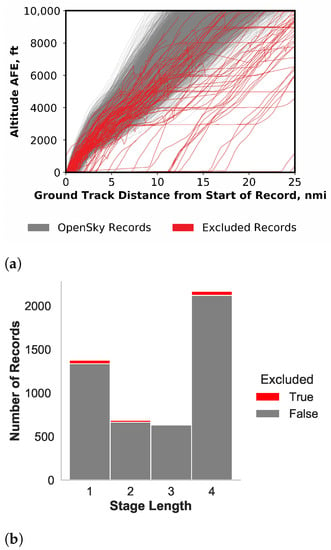
Figure 2.
OpenSky records excluded from analysis. (a) Altitude profile; (b) distribution of OpenSky records.
The trajectories in OpenSky dataset and NADP profiles modeled in AEDT are then resampled at a fixed cumulative ground track distance interval of 0.1 nmi and aligned with NADP profiles for comparison. The alignment point is chosen to be 35 ft above field elevation (AFE) to remove shifts between OpenSky and NADP due to the lack of takeoff ground roll segment in the OpenSky dataset. The start of the ground track is moved to this alignment point.
3.2. Trajectory Comparisons
Since NADP and OpenSky trajectories are resampled at the same interval and aligned to start at the same point, the difference between the two datasets can be computed per data point pair along the ground track. The relative mean percentage errors (MPE) in altitude and ground speed between OpenSky and NADPs are computed along the departure profiles using Equation (1), where n is the minimum number of points in two profiles being compared, and x is the parameter being compared. Positive MPE indicates an overprediction by NADP. Departure trajectories are compared from 35 ft AFE to 10,000 ft MSL at the end of terminal airspace. Each OpenSky trajectory is compared to NADP 1-1 and NADP 2-11 procedural profiles at its respective stage length and the 4 thrust levels are defined in Table 1.
3.3. Noise Modeling
In a previous study by the authors [8], clustering algorithms were utilized to identify and group common real-world operations. Agglomerative hierarchical clustering algorithms are applied to the top 5 airlines with the most flight records from the OpenSky dataset to cluster similar flight operations based on altitude and ground speed profiles. Clustering is accomplished per airline–stage length group, allowing the results to be matched with NADP by stage length. A median representative profile is then determined for each cluster based on the minimum Root-Mean-Square (RMS) difference between actual flight records and the ideal median profile within each cluster. Groups with less than 25 flights are considered uncommon operations and are excluded from this process. This process results in 74 median representative profiles.
The median representative profiles are then converted to FPPs and flown in AEDT to generate noise results. Since the OpenSky dataset does not contain thrust information, the thrust at each point along the trajectory has to be estimated. Using empirical equations, thrust coefficients within AEDT ANP database [15] are utilized to calculate thrust at each point [16]. Each median FPP is modeled with the combinations of thrust cutback altitudes and reduced thrust amount used to model NADP, as shown in Table 1. Additionally, takeoff ground roll segment performance results from NADP procedural profiles are converted to FPP and added to the beginning of each median FPP. This is accomplished to avoid high noise difference resulting from OpenSky’s lack of takeoff ground roll segment. Ground speed and thrust level for the takeoff ground roll segment of each FPP are taken from NADP of equal stage length and reduced thrust amount. The values are obtained up to the last point where NADP ground speed and thrust continuously increase or decrease when placed before the initial point of OpenSky FPP, respectively. The resulting 592 FPPs (74 medians, each with 2 cutback altitudes and 4 RT levels) are illustrated in Figure 3. All profiles are modeled up to 10,000 ft MSL as departing from KSFO runway 01L assuming AEDT average annual airport weather [17] over a noise receptor grid of 30 nmi by 30 nmi with 0.2 nmi grid spacing.
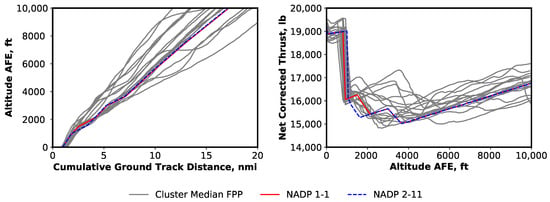
Figure 3.
OpenSky cluster median fixed-point and NADP procedural profiles modeled in AEDT.
4. Results
4.1. Representative NADP Profile and Reduced Thrust
Trajectory comparison results are first examined to determine reduced thrust (RT) level and NADP profile most representative of the OpenSky B737-800 KSFO departures. The processed OpenSky trajectories are compared to NADP 1-1 and NADP 2-11 modeled in AEDT at RT0, RT5, RT10, and RT15. The trajectory comparison results are aggregated by NADP profile and RT levels. Figure 4 illustrates this result as box plots with each bar representing MPE results from all airline and stage lengths. Positive and negative MPE indicate over-prediction and under-prediction by NADP, respectively.
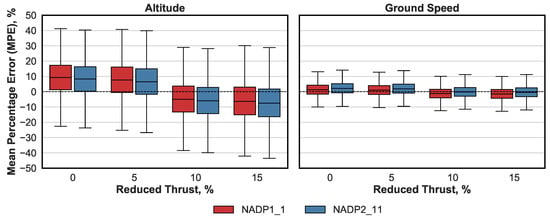
Figure 4.
Overall trajectory comparisons between real operations and NADPs at varying thrust levels.
Altitude comparison results indicate that NADP 1-1 RT10 (90% takeoff thrust and 90% climb thrust) is the most representative with a median of 4.96% under-prediction by NADP and an interquartile range (IQR) of 8.63%. NADP 2-11 RT10 is the second most representative with a median of 5.91% under-prediction. For ground speed, the most representative case is NADP 2-11 RT10 with a median of 0.18% under-prediction and an IQR of 2.89%. The median ground speed difference for NADP 1-1 RT10 is 1.25% under-prediction.
Averaging the magnitude of altitude and ground speed differences for NADP 1-1 RT10 and NADP 2-11 RT10 results in an overall trajectory difference of 3.11% and 3.05%, respectively. Hence, NADP 2-11 RT10 is the preferred profile for representing the average behavior of this set of flight trajectories.
4.2. Trajectory Comparison by Airline–Stage Length Group
Trajectory comparison results are then aggregated by airline–stage length group where operating procedures between different airlines can be compared against NADP profiles. Figure 5 visualizes a sample result compared to the most representative NADP and RT trajectory, with red and blue blocks indicating the median over-prediction and under-prediction by NADP, respectively. The top five airlines with the most flight records are shown, with the rightmost column indicating the median across all stage lengths for each airline. The bottom column indicates the median across all 10 airlines for each stage length. Airline–stage length groups with less than 25 flights are considered uncommon operations and, therefore, excluded. Although overall results indicate 5.91% and 0.18% under-prediction in altitude and ground speed, respectively, there exist large variations in altitude profiles between the various airline–stage length groups. For example, airline one tends to fly higher altitude profiles than NADP and does so to a greater extent at higher stage lengths, while airlines four and five tend to fly lower altitude profiles. Averaging the magnitude of altitude and ground speed differences for overall trajectory difference, airline 4–stage length 4 has the minimum difference of 2.10%, and airline 4–stage length 2 has the maximum difference of 7.45%.
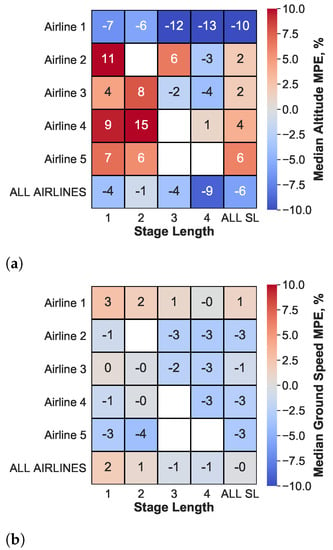
Figure 5.
Trajectory difference between NADP2-11 RT10 and real operations by airline–stage length; positive MPE indicates NADP is higher. (a) Altitude; (b) ground speed.
4.3. Noise Comparison Results
Each airline–stage length group is further sub-divided into common operational patterns represented by median profiles found by using clustering. Clusters with singular flight are considered as outliers and, therefore, excluded from noise comparison.
Figure 6 illustrates the difference in sound exposure level (SEL dB) results for the airline–stage length group with the minimum overall trajectory difference. Red regions indicate that more noise is produced while blue regions indicate less noise is produced by NADP as compared to cluster median FPPs. Contour lines overlaid on heat maps show the noise result of each cluster median FPP. Since profiles are modeled up to 10,000 ft MSL, noise differences toward the top right where one of the profiles may have terminated prior to the other should be ignored. Uncertainties also exist at the start of flight due to takeoff ground roll and thrust cutback altitude assumptions. Cluster #4 has the most considerable difference prior to the end of the profile but is a less common flight operation containing only three flight records.
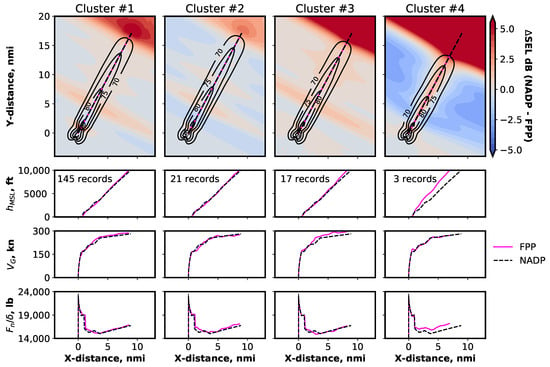
Figure 6.
SEL dB difference between NADP 2-11 RT10 and Airline 4–Stage Length 4 cluster medians (—altitude MSL; —ground speed; —net corrected thrust per engine).
Figure 7 shows the variability within the 70 SEL dB contour area with all cluster medians in each airline–stage length group aggregated together, excluding single flight clusters. The shorter trajectory’s 70 SEL dB contour area is used as the reference area to exclude the end of profile errors. The majority of noise differences are observed to be within ±2 SEL dB, with maximum and minimum noise differences within +8 and −10 SEL dB, respectively. No significant bias towards over-prediction or under-prediction was observed. Note that NADP profiles are meant to represent a typical operation averaged across all real-world operations. As such, Figure 6 and Figure 7 should be interpreted as the variability in the noise grid within a single airline and across multiple airlines not captured when using NADP definitions to represent real-world operations.
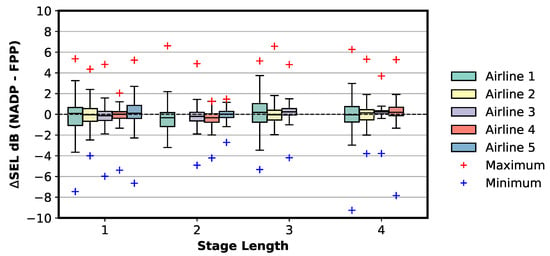
Figure 7.
SEL dB difference between NADP 2-11 RT10 and aggregated cluster medians within the 70 SEL dB contour area.
The methodology presented here can be subsequently extended to larger datasets at multiple airports and weather conditions, enabling additional sources of variability to be investigated. Employing more accurate estimation of weight and thrust information from ground-based trajectory data [18,19] can enable higher fidelity analysis. Additionally, improvements to clustering can be made by employing weighted distance functions in order to better identify departure traffic flows close to the terminal airspace [20].
5. Conclusions
By using data-driven techniques, this paper quantified variations in flight trajectory and noise impact between B737-800 real-world operations obtained from OpenSky ADS-B data and NADP profiles at the KSFO airport. Results indicate that the presented methodology can efficiently compare large-scale aircraft tracking data to NADP and quantify the resulting variability in trajectory and community noise impact. NADP 2-11 modeled at 90% takeoff and 90% climb thrust is the most representative of the real-world operations analyzed in terms of trajectory, with an overall difference in both altitude and ground speed of 3.05%. Noise comparison results quantified variability across the noise grid not captured by the most representative NADP profile. The majority of noise differences within the 70 SEL dB contour area were observed to be within ±2 SEL dB, with maximum and minimum noise differences within +8 and −10 SEL dB, respectively. By quantifying variations in flight trajectory and noise impact, this study provides a framework for comparing and choosing the appropriate NADP profile to model a given context using open-source datasets, thereby laying the foundation for future impact assessment and mitigation efforts.
Author Contributions
Conceptualization, J.B. and T.G.P.; data curation, J.B.; methodology, J.B.; formal analysis, J.B.; funding acquisition, T.G.P. and D.N.M.; investigation, J.B.; resources, D.N.M.; project administration, T.G.P; supervision, D.N.M.; visualization, J.B.; writing—original draft, J.B.; writing—review and editing, T.G.P. All authors have read and agreed to the published version of the manuscript.
Funding
This work was funded by the US Federal Aviation Administration Office of Environment and Energy as a part of ASCENT Project 54 (Project Number 13-C-AJFE-GIT-054). Any opinions, findings, and conclusions or recommendations expressed in this material are those of the authors and do not necessarily reflect the views of the FAA or other ASCENT Sponsors.
Acknowledgments
The authors would like to acknowledge OpenSky Network for providing access to the data utilized in this work. In addition, the authors would like to thank Joe DiPardo and Mohammed Majeed at FAA/AEE, Robert Downs at the US Department of Transportation Volpe center, and Michelle R. Kirby and Ameya Behere at the Aerospace Systems Design Laboratory for their guidance and support.
Conflicts of Interest
The authors declare no conflict of interest.
Abbreviations
The following abbreviations are used in this manuscript:
| AEDT | Aviation Environmental Design Tool |
| AFE | Above Field Elevation |
| FAA | Federal Aviation Administration |
| FPP | Fixed-Point Profile |
| ICAO | International Civil Aviation Organization |
| MPE | Mean Percentage Error |
| MSL | Mean Sea Level |
| NADP | Noise Abatement Departure Procedure |
| RT | Reduced Thrust |
| SEL | Sound Exposure Level |
| SL | Stage Length |
References
- Federal Aviation Administration, Automatic Dependent Surveillance—Broadcast (ADS-B). 2020. Available online: https://www.faa.gov/nextgen/programs/adsb/ (accessed on 20 December 2021).
- Ganic, E.; Dobrota, M.; Babic, O. Noise abatement measures at airports: Contributing factors and mutual dependence. Appl. Acoust. 2016, 112, 32–40. [Google Scholar] [CrossRef]
- Federal Aviation Administration Advisory Circular 91-53A–Noise Abatement Departure Profiles. 1983. Available online: https://www.faa.gov/documentLibrary/media/Advisory_Circular/ac91-53.pdf (accessed on 20 December 2021).
- International Civil Aviation Organization Doc 8168 OPS/611 Procedures for Air Navigation Services, Aircraft Operations: Volume I Flight Procedures. 2006. Available online: https://store.icao.int/en/procedures-for-air-navigation-services-pans-aircraft-operations-volume-i-flight-procedures-doc-8168 (accessed on 20 December 2021).
- Federal Aviation Administration, AEDT and Legacy Tools Comparisons. 2016. Available online: https://aedt.faa.gov/Documents/Comparison_AEDT_Legacy_Summary.pdf (accessed on 20 December 2021).
- ASCENT Project 045 Annual Report 2018. Available online: https://ascent.aero/documents/2019/07/ascent-project-045-2018-annual-report.pdf (accessed on 20 December 2021).
- Gao, Z.; Behere, A.; Li, Y.; Lim, D.; Kirby, M.; Mavris, D.N. Development and Analysis of Improved Departure Modeling for Aviation Environmental Impact Assessment. J. Aircr. 2021, 58, 847–857. [Google Scholar] [CrossRef]
- Behere, A.; Bhanpato, J.; Puranik, T.G.; Kirby, M.; Mavris, D.N. Data-driven Approach to Environmental Impact Assessment of Real-World Operations. In AIAA Scitech 2021 Forum: Virtual, 11–15. 19–21 January 2021; American Institute of Aeronautics and Astronautics, Inc.: Reston, VA, USA, 2021. [Google Scholar] [CrossRef]
- Lim, D.; Behere, A.; Jin, Y.C.D.; Li, Y.; Kirby, M.; Gao, Z.; Mavris, D.N. Improved Noise Abatement Departure Procedure Modeling for Aviation Environmental Impact Assessment. In AIAA Scitech 2020 Forum: Orlando, FL, USA, 6–10 January 2020; American Institute of Aeronautics and Astronautics, Inc.: Reston, VA, USA, 2020. [Google Scholar] [CrossRef]
- Behere, A.; Isakson, L.; Puranik, T.G.; Li, Y.; Kirby, M.; Mavris, D.N. Aircraft Landing and Takeoff Operations Clustering for Efficient Environmental Impact Assessment. In AIAA Aviation 2020 Forum: Reston, VA, USA, 15–19 June 2020; American Institute of Aeronautics and Astronautics, Inc.: Reston, VA, USA, 2020. [Google Scholar] [CrossRef]
- ASCENT Project 045 Annual Report 2020. Available online: https://s3.wp.wsu.edu/uploads/sites/2479/2021/03/ASCENT-Project-045-2020-Annual-Report.pdf (accessed on 20 December 2021).
- Thomas, J.L.; Hansman, R.J. Framework for Analyzing Aircraft Community Noise Impacts of Advanced Operational Flight Procedures. J. Aircr. 2019, 56, 1407–1417. [Google Scholar] [CrossRef]
- Behere, A.; Rajaram, D.; Puranik, T.G.; Kirby, M.; Mavris, D.N. Reduced Order Modeling Methods for Aviation Noise Estimation. Sustainability 2021, 13, 1120. [Google Scholar] [CrossRef]
- Schäfer, M.; Strohmeier, M.; Lenders, V.; Martinovic, I.; Wilhelm, M. Bringing Up OpenSky: A Large-scale ADS-B Sensor Network for Research. In Proceedings of the 13th IEEE/ACM International Symposium on Information Processing in Sensor Networks (IPNS), Berlin, Germany, 15–17 April 2014; pp. 38–94. [Google Scholar]
- EUROCONTROL Experimental Center (EEC), Aircraft Noise and Performance Database. 2020. Available online: http://www.aircraftnoisemodel.org/ (accessed on 20 December 2021).
- Aviation Environmental Design Tool (AEDT) Version 3c Technical Manual. 2020. Available online: https://rosap.ntl.bts.gov/view/dot/49820/dot_49820_DS1.pdf? (accessed on 20 December 2021).
- Gabrielian, A.B.; Puranik, T.G.; Bendarkar, M.V.; Kirby, M.; Mavris, D.; Monteiro, D. Noise Model Validation Using Real World Operations Data. In AIAA Aviation 2021 Forum: Virtual, 2–6 August 2021; American Institute of Aeronautics and Astronautics, Inc.: Reston, VA, USA, 2021. [Google Scholar] [CrossRef]
- Alligier, R.; Gianazza, D.; Durand, N. Learning the aircraft mass and thrust to improve the ground-based trajectory prediction of climbing flights. Transp. Res. Part Emerg. Technol. 2013, 36, 45–60. [Google Scholar] [CrossRef] [Green Version]
- Sun, J.; Blom, H.; Ellerbroek, J.; Hoekstra, J. Aircraft Mass and Thrust Estimation Using Recursive Bayesian Method. In Proceedings of the 8th International Conference on Research in Air Transportation, Barcelona, Spain, 26–29 June 2018. [Google Scholar]
- Corrado, S.J.; Puranik, T.G.; Pinon, O.J.; Mavris, D.N. Trajectory Clustering within the Terminal Airspace Utilizing a Weighted Distance Function. Proceedings 2020, 59, 7. [Google Scholar] [CrossRef]
Publisher’s Note: MDPI stays neutral with regard to jurisdictional claims in published maps and institutional affiliations. |
© 2021 by the authors. Licensee MDPI, Basel, Switzerland. This article is an open access article distributed under the terms and conditions of the Creative Commons Attribution (CC BY) license (https://creativecommons.org/licenses/by/4.0/).